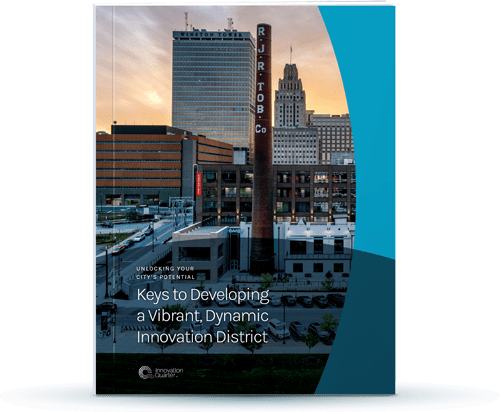All too often, we hear about the barriers to academic-industry collaboration and parnterships. Academia moves too slowly for eager startups. Risk-averse, financially motivated corporations stifle academic research and development.
The truth is, partnerships between academic and corporate entities are becoming key to accelerating research, innovation and product development. The two institutions provide each other with talent, resources and perspectives to spark new ideas and lead to cutting-edge solutions.
Fostering Academic-Industry Collaborations in Innovation Districts
Innovation districts combine economic, spatial and social networking assets to create an innovation ecosystem that stimulates partnerships, connectivity and collaboration. This environment is prime for developing relationships between academia and industry entities to set organizations ahead of their competition.
Innovation districts must employ intentional, collaboration-based strategies to foster successful academic-industry partnerships that strengthen networks and push the limits of innovation.
Identify Anchor Institutions and Their Strengths
Creating a competitive advantage is one of the five strategies identified by the Global Institute of Innovation Districts (GIID) that successful innovation districts use to differentiate themselves from other districts and areas of innovation.
An innovation district must identify its niche and work to attract the firms, institutions and organizations that will best enhance its focus and development potential and be a good fit for the environment. This is often done by auditing the current players and anchor institutions to determine their shared values and strengths, ultimately to find others that align with them. Specializing in a few sectors, rather than trying to appeal to any and all players, allows the innovation district to attract a variety of similar yet complementary firms, develop spaces and encourage partnerships that further strengthen the competitive advantage.
Recognizing the value of specialization and the expertise of a partner like the Wake Forest Health System, the Innovation Quarter intentionally established value & health transformation, healthy aging, virtual health, personalized care & precision medicine and learning systems as its key focus areas. As a result, the Innovation Quarter has emerged as a healthtech leader in these sectors.


Serve as a Matchmaker for Cross-Sector Relationships
The GIID also notes that sophisticated innovation districts strategically facilitate the convergence of individuals, firms and institutions from disparate disciplines. Innovation districts can play a significant role in establishing these vibrant networks, and their “matchmaking” abilities are critical to developing partnerships with academic institutions.
Innovation districts aren’t just the creators of spaces—they play a role in activating them. Innovation districts provide the space for both formal and informal connections across disciplines to take place. In an “it’s-who-you-know” world, innovation districts converge people and ideas by helping players navigate the intricacies of cross-sector partnerships and creating the physical spaces where networking and collaboration can occur.
We know programming is crucial for building a robust innovation ecosystem. The iQ facilitates convergence through well-designed programs and networking events that engage individuals from various disciplines, academic institutions and corporate firms.



Why Academic-Industry Collaboration?
Academic-industry collaboration can stimulate and strengthen research and development initiatives, but innovation districts provide the framework for those fruitful partnerships. If partnership is the play, with many different actors combining their talents, innovation districts are the stage.
Without the resources, proximity and reasons for cross-sectoral interactions that innovation districts facilitate, it can be difficult and slow for these partnerships to take off. By focusing on establishing a collaborative environment and serving as an intermediary between disparate industries, innovation districts can achieve mutually beneficial engagement among partners that pushes research and development forward.




